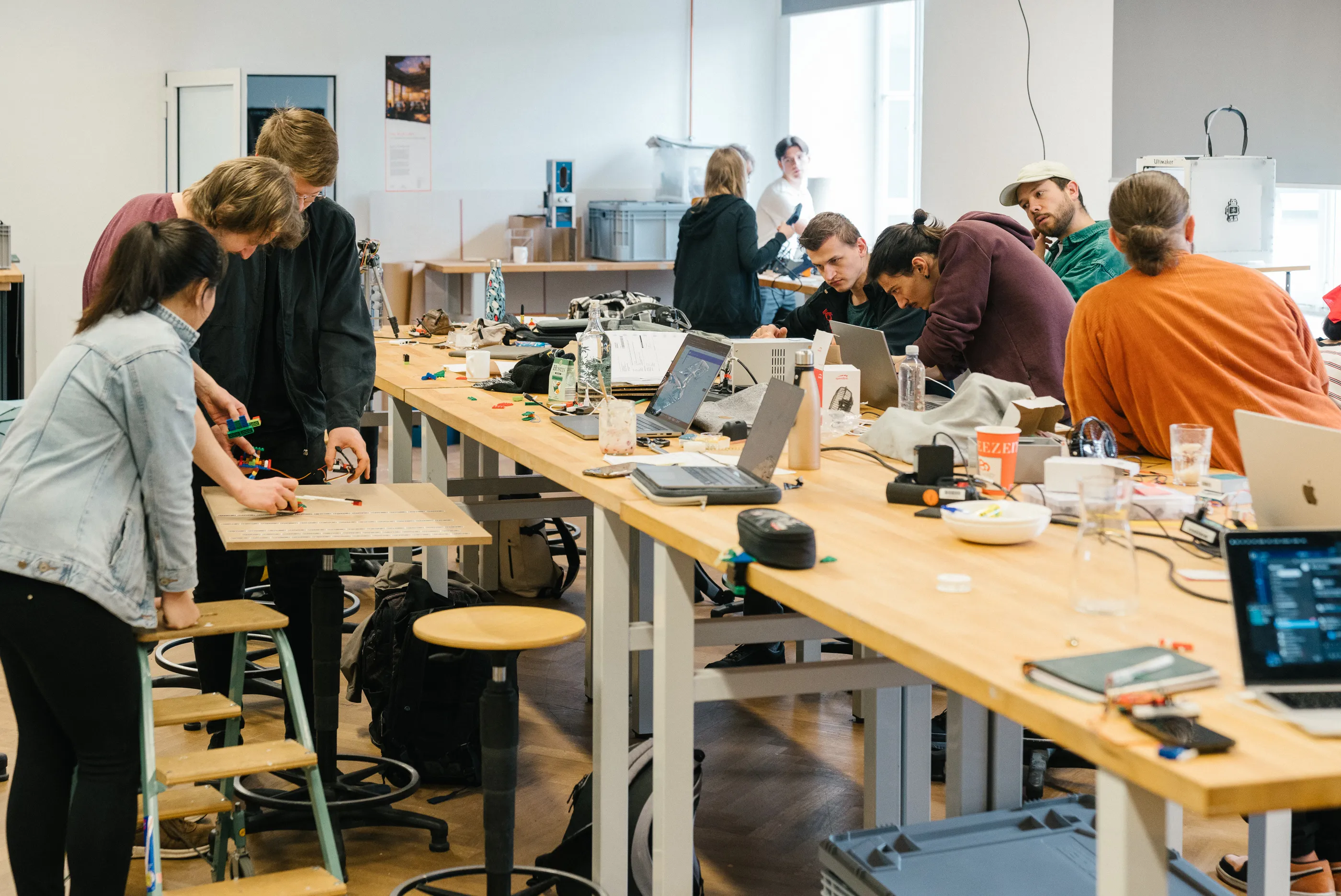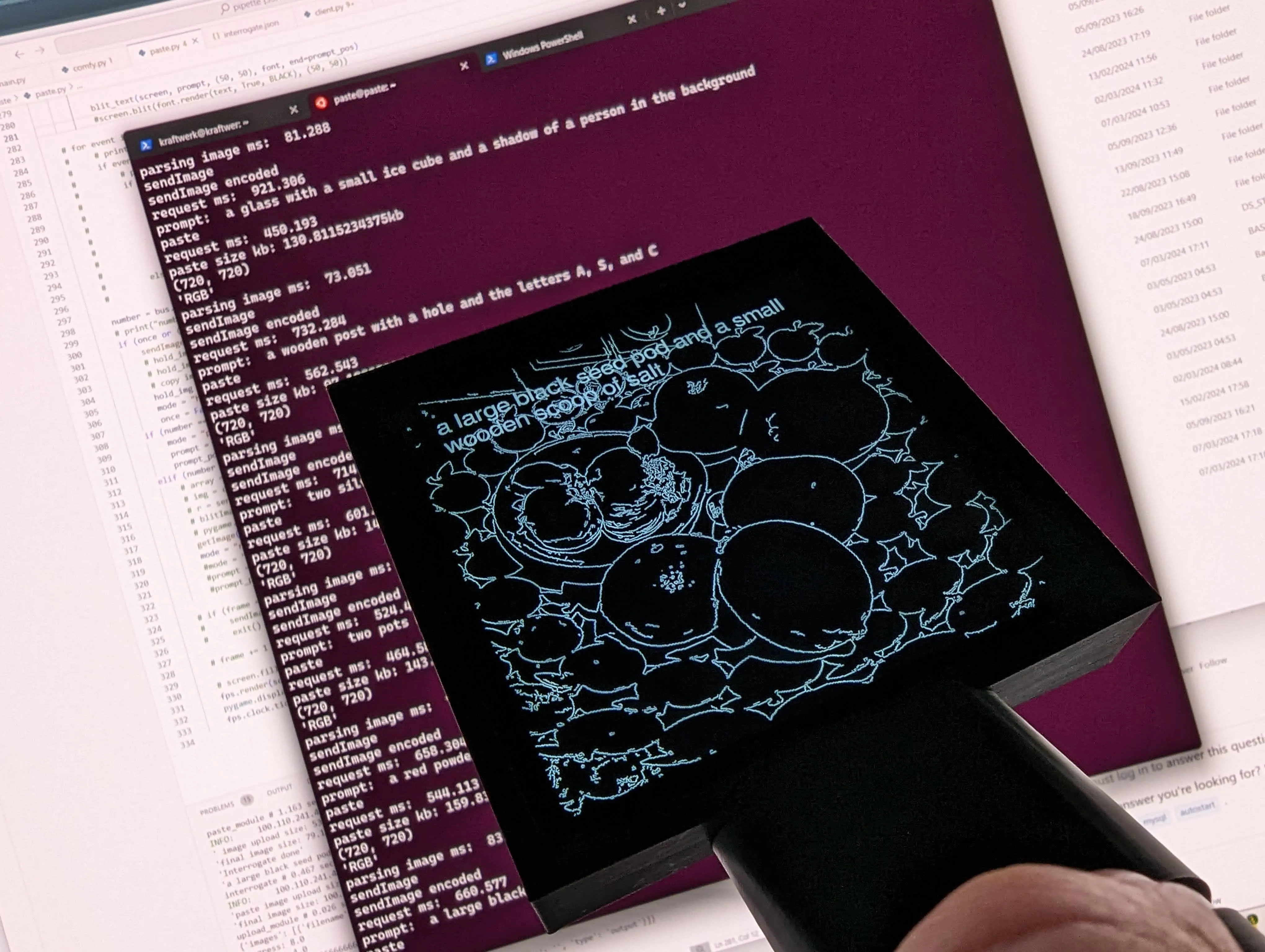Progress Report: Learnings and experiences from the last two years

We look back on two years of teaching AI at HfG Schwäbisch Gmünd. Two years in which we worked together with the KITeGG project consortium on the goal of integrating AI into design education, and two years after we formulated our first thoughts and goals on this topic [1]. In spring 2023, we published an article on the subject. What has happened since then, what experiences and lessons have we learned, and how has our view of things at Schwäbisch Gmünd changed?
Looking back: Our goals for the integration of AI into design teaching at the HfG Schwäbisch Gmünd
The high technical and conceptual complexity and rapid development in AI technologies make it difficult for designers, especially design teachers, to keep track of what AI could offer their respective fields. It is even more challenging to keep pace with the technical implementation of these possibilities.
One question that has, therefore, accompanied us since the beginning of the project is to what extent we, as designers, need to immerse ourselves in the technical level of AI and how we can still focus on the core competencies of our discipline. Conceptual engagement with AI technologies without technical background knowledge leads to unrealistic fictional designs, and designers have found it challenging to develop interesting AI-based use cases. Therefore, We have thought about what we think design students need to know about AI to create engaging, meaningful, and feasible designs. Our goal for teaching was to provide students with an “AI intuition” - a technical intuition for the effects of the technology and its limitations. In this way, we want to offer students just as much technical discussion and basic knowledge as necessary to enable them to engage with the technology appropriately.

The AI+Design Lab
An overarching goal of the KITeGG project is integrating AI teaching into the design curriculum. One challenge we faced at HfG Schwäbisch Gmünd is the already full curriculum of the individual degree programs. This leaves hardly any room for adding new modules without shortening or replacing existing ones. At this point, we see a general problem that many universities will face when deciding what space AI should occupy in design teaching and the curriculum. Our approach to dealing with this problem is the idea of the AI+Design Lab as a cross-university location for AI expertise.
The AI+Design Lab is a contact point for students, who can find targeted advice and technical support for their projects here. It offers introductory courses for the development of technical “AI intuition.” The intuition imparted enables students to make informed decisions about using AI technologies. They learn to assess the possibilities and limitations as well as the effort and costs involved in developing and implementing AI systems. In addition, they will be able to use existing technologies in creative and unconventional ways and use frameworks and tools to prototype and test the AI-based interactions they have designed. Students are sensitized to the possible consequences of AI technologies and learn to mitigate or avoid potential side effects through design decisions. In addition, precise language on AI topics is taught to prepare students for communication within interdisciplinary project teams and with stakeholders.
In addition to advising students, the lab provides a contact point for lecturers and integrates into existing project-based teaching. This allows for incorporating current and specialized AI knowledge on specific topics into teaching across the university.

Learnings and experiences from the last two years
We are taking stock after six months of setting up and one and a half years of operating the AI+Design Lab at HfG Schwäbisch Gmünd. What have we achieved so far? What has worked well? Where do we still see the potential for expansion?
Courses offered by the AI+Design Lab and how they are anchored in the curriculum
At the HfG in Schwäbisch Gmünd, we were able to firmly anchor three basic course formats in the curriculum to develop students’ technical intuition concerning AI technologies. One course takes place in the Interaction Design Bachelor’s program and two in the Strategic Design Master’s program. In addition, we established further course formats during the workshop week, which takes place once a semester. These are one-week, more practical-experimental workshop formats in which students deal conceptually with AI technologies. The module is a compulsory elective module that can be chosen across all Bachelor’s degree programs.
Due to the structural hurdles, we could not integrate any other course formats into the curriculum besides the individual project supervision offered. However, we still see great potential here regarding the technical and conceptual level of teaching and projects relating to AI technologies. For example, we believe it is essential to offer a compulsory AI basics course in all degree programs to be able to draw on basic knowledge in further courses or project supervision. In addition, we believe it is essential to offer elective project courses with a specific reference to AI to enable interested students to develop further in this area and to explore and help shape current technological developments in teaching. The results of these courses can, in turn, serve as “best-practice examples” that convey the current possibilities of the technology and inspire both students and lecturers, and drive forward the conceptual development and implementation of exciting projects.
To date, we have implemented our own projects in the lab for this purpose, which both keep us up to date with the latest developments and communicate the possibilities of the technology. For example, we created the Unstable Mirror project. This mixed-media installation draws attention to the options but also, in particular, to the limitations and inherent prejudices of generative AI. In addition, the project Transferscope was created, a tool with which the possibilities of image-generative diffusion models in connection with ControlNets (models that offer significantly better control over the generated content via edge or line detection, for example) can be explored in an explorative and low-threshold manner. The implemented tools also always have an educational level and can be used in teaching or the (university) public sector, for example, to make ethical implications visible and address them with the Unstable Mirror.
In addition, we at the AI+Design Lab are developing specific tools for teaching learning content. SandwichNet, for example, is a teaching tool that offers an interactive and playful approach to teaching the basics of machine learning, with a focus on neural networks. We use the tool to accompany primary teaching in various course formats, and it is freely available to students and other lecturers.

Connection to existing teaching formats and project courses
In addition to offering its courses, the AI+Design Lab is also keen to build on existing teaching formats. Colleagues take advantage of our offer to give short primer formats on AI in their courses. These offerings allow them to incorporate current and specialized AI knowledge on their subject area into their teaching, even if they do not (yet) have the necessary expertise.
Our experience over the last year and a half has shown that more AI input for lecturers would be beneficial. This would anchor knowledge sustainably at the university even after the project ends and prevent the unconscious promotion of technically unrealistic concepts. We are, therefore, planning special input formats on AI for lecturers in the winter semester of 2024/25.
The lab’s support services were able to integrate with teaching across all degree programs and have already become well-established at the university. For example, students from other lecturers’ project courses come to us for advice when dealing with an AI-relevant topic or are sent to us specifically by the lecturers.
Our experience has shown that it is crucial for students to find out about our offer promptly at the start of the project and come to us for advice. Technically unrealistic ideas and perceptions of the possibilities of AI technologies are often already anchored at an advanced stage of the concept phase, and students are frequently frustrated when they have to discard or heavily adapt their concept. This sometimes leads to the rejection of our offer and the insistence on fictitious concepts.
The university has also established a system for supervising Bachelor’s and Master’s theses related to AI by those involved in the project.
Visibility and accessibility of the lab
Despite the good influx of requests for supervision and support and the integration into the curriculum, we have noticed in recent years that the Lab’s cross-university “satellite role” still makes it difficult to generate attention and awareness of the existence of the AI+Design Lab among students across all degree programs, especially among new students. For this reason, the Lab regularly offers event formats that draw attention to the Lab and involve students. For example, a regular “Prompt Battle” format was established, which is now organized and further developed by students.
The Lab also provides information about all the latest news, events, and achievements on this website.
In 2023, we started setting up a digital lab to improve accessibility to its resources. This enables providing resources such as link collections on specific topics, tutorials, best-practice results, or documentation that students and teachers can access quickly and asynchronously. The digital lab is also intended to help establish AI knowledge at the university in the long term.
Looking back on the last two years, we see great potential in the lab’s cross-course position as a place of specialization and will continue to expand and test this concept in the coming year.

Illustration by Mark Jonathan Freyer
Ressources
- [1] Rahel Flechtner and Aeneas Stankowski. 2023. AI Is Not a Wildcard: Challenges for Integrating AI into the Design Curriculum. In EduCHI 2023: 5th Annual Symposium on HCI Education (EduCHI ’23), April 28, 2023, Hamburg, Germany. ACM, New York, NY, USA. DOI: 10.1145/3587399.3587410.

